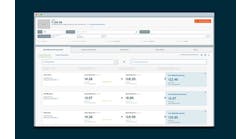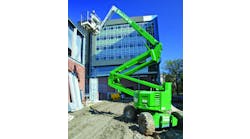Business is better these days for most rental companies, but as many learned during the last recession, careful cost management is key to survival. One of the biggest costs is keeping transportation vehicles on the road, including delivery trucks, service vehicles and fleet vehicles used by sales and management staff. As business improves, more vehicles are in use and the costs rise proportionally.
While fuel costs vary from week to week, for the most part the arc goes upward. There are far too many variables to be able to accurately predict where fuel prices will be two years from now, but it's safer to plan on them being higher than lower. We don't know if we'll see $6 a gallon in the next couple of years, but it's more likely than $2 a gallon.
Rental companies are taking the costs of fuel seriously and are constantly looking to lower costs. With this in mind, RER talked with a variety of rental people in search of tips. Here are some of their ideas.
A rental company has branches in the northeast, northwest, southeast and southwest regions of a city, but if they have a truck going from the southwest to the northeast to deliver equipment to a customer and vice versa, they are wasting time and fuel. Ray Nibbe, operations manager for Aurora, Colo.-based Wagner Equipment calls this “trucks passing in the night” and without central coordination this is a common occurrence, not only for multi-location companies but single-location rental centers as well that go from one end of their market area to another without coordinating. Centralized dispatch, whether it's controlled by a computer or a guy sticking pins in a board, can reduce or even eliminate this problem. It's a matter of communication, whether verbal or electronic.
“In our metro locations where we have multiple stores, our delivery and service fleet are centrally dispatched to improve efficiency,” says Jeff Vance, regional operations manager, Sunstate Equipment, based in Phoenix. “We are able to avoid crisscrossing our delivery fleet because all trucks are dispatched out of a single location. Our dispatchers have the visibility of what is going on at all locations and can make educated decisions about where to deliver a piece of equipment from. We use a specialized dispatching software that we designed. The software has multiple tools so we can monitor dispatch and driver efficiency.”
Wagner Equipment, which centralizes all transportation requests — from the rental as well as dealership segments of its business — has improved its “loaded miles” ratio from about 40 percent to better than 65 percent since it began the measuring system and centralization, which involves electronic requests for all transportation.
“We have a central dispatch system for our four locations in the northern Virginia area,” says Joel Theros of Gainesville, Va.-based Theros Equipment. “It greatly improves our efficiency both in terms of utilizing fleet that may be idle at one store when another store needs it, and by reducing the number of trucks on the road, reducing unnecessary trips caused by possible lack of communication among the stores, and by greatly reducing the amount of fuel burned and unnecessary wear and tear on the vehicles, not to mention hours logged by drivers.”
Dispatching systems such as Cube Route, made by Descartes and utilized by Toronto-based Stephenson's Rental Services and others, electronically organizes deliveries for Stephenson's, which has 20 locations in the greater Toronto area, which could be the epitome of a “trucks crisscrossing” situation if not centrally controlled. Cube Route facilitates communication between driver and dispatcher by avoiding the constant clutter of two-way radio systems. With one touch of a button, a driver can communicate that he has arrived at his destination, is waiting for equipment or departing for his next delivery.
Stephenson's has reduced fuel costs by close to 50 percent since it began using the system, and other rental companies have also cut costs with other software systems. Some commonly used software systems designed for rental management include dispatching modules.
“Point of Rental's dispatch system allows us to lay out and map the routes for the most efficient moves,” says Dale Blackwell, director of the California Rental Association and owner of Sacramento, Calif.'s Aba Daba Rentals & Sales. “This has helped us cut down on duplicate area moves.”
Another way to cut delivery costs is to try to emphasize long-term rental as opposed to short. A company's sales staff can develop incentives for long-term rentals, but also must seek out the kind of clientele that is more likely to rent on an extended basis.
“Historically we've had a lot of short-term rentals,” says Rob Wilson, vice president of fleet services for Stephenson's. “A lot of our core business has been short term — day, week and month. We're really trying hard to get 3-, 6-, 12- and 24-month rentals so we don't have to keep having those costs coming in and out.”
It sounds simple but free or discounted delivery is utilized by too many rental companies and aggressive sales reps seeking to beat the competition. As the price of fuel goes up, so must delivery rates. Many rental firms are implementing fuel surcharges that are indexed to the price of fuel above a certain level. Some rental companies, such as Howe Rental & Sales, West Murray, Utah, charge automatically according to zip code, with farther zip codes obviously charged more.
“I would like to see rental companies in general do a better job of charging prices for pick-up and delivery that cover costs and show that we're a smart industry that is here to stay,” says Theros, echoing the sentiment of many. “Too many companies deliver equipment free or charge low fees that do not cover the cost. The customers know that fuel prices are high and the cost of big diesel trucks continues to go up, so it should not be shocking that a rental company wants to recoup its delivery and pick-up costs.”
Rental companies cannot afford a lax attitude when it comes to customers' use of fuel in the machines they rent and many have policies similar to car rental companies. When a customer rents a car with a full tank, the normal policy is if the tank isn't full, the customer pays considerably more per gallon for the fill-up. Most customers understand that they pay extra for the time, service, convenience and overhead as long as it is stated in the contract.
“When our customers consume fuel on the rental, we bill that back per liter,” says Stephenson's Wilson. “Let's say it costs $1.20 per liter of gas; we bill it back at about $2.25. We let our customers know right up front that if they return it empty, each liter is going to be $2.25.”
The more fuel a rental company buys, the more leverage they have to negotiate the terms. Stephenson's negotiated another incentive for its gasoline supplier to reduce the price: If it pays its fuel supplier within seven to 10 days, it gets a better price. Another favored negotiating method is to make sure the price of fuel is pegged to the refinery's cost, rising or falling accordingly.
Fuel cards such as Voyager and others are utilized by many rental companies to save on costs. Associations, in some cases, provide deals for their members as well.
“CRA negotiated a special discount for its members to purchase through CFN and Pacific Pride cardlock networks,” says Aba Daba's Blackwell. “We use this service for the best price for coop buying.”
Fuel suppliers can offer additional benefits. “We partner with suppliers that offer multiple products that we consume,” says Sunstate's Vance. “For instance, we try to buy our oil, lubricants, grease and fuel from the same vendor.”
Stephenson's, Seattle-based Star Rentals and others started buying hybrid vehicles for sales staff or vehicles such as Ford's F-150 pickups that are equipped with EcoBoost engines that get better mileage. Quite a few companies are looking at alternative fuels for delivery trucks; most have, to this point determined that the cost savings, and availability of supply and service infrastructure are not yet widespread and economical enough, but that the time will come in a few years.
The costs of idling are very high. Increasingly newer delivery vehicles include idle shut-off systems. “The vast majority of our large trucks are equipped with engine idle management systems that turn vehicles off automatically after several minutes,” says Bob Kendall, CEO of Star Rentals.
“Our trucks will idle for five minutes then shut down to eliminate wasted fuel sitting on our yards or jobsites,” says Sunstate's Vance.
For those companies that don't have electronic controls, educating drivers on the costs of idling is valuable and an important part of driver training. Ensuring that all trucks immediately are shut off when returning to the yard or during deliveries is a simple money-saving action.
Wagner Equipment finds it effective to incentivize drivers to reduce idling. “We have a goal of 15 percent or less for all of our trucks,” says operations manager Nibbe. “And we give the drivers a little spiff. The drivers that maintain that 15 percent or less per month, we give them a $25 gift card. We've seen some pretty significant fuel savings from managing our idle time.”
Driver training can include important safety elements and DOT-compliance training as well as fuel efficiency aspects. Star Rentals has “a very intense driver training program that encompasses three to four weeks of orientation including vehicle operation, safety training, equipment operation training and certification, defensive driver training, driver test and check rides with our risk manager,” says Kendall.
Some rental companies also use American Rental Association's driver training module.
Historically, lowering delivery rates or even offering free delivery has been common in the rental industry. Now some companies are not allowing sales staff to offer free delivery and placing limits on delivery discounts.
Star Rentals' Kendall says the company is using late-model delivery trucks and carefully studies mileage statistics on different makes and models on a regular basis. The average age of Star's delivery fleet is less than three years.
Although dispatching software has a certain level of popularity, others point out the human element is still important. “We believe there is not an adequate replacement for experienced dispatch personnel working together with a very high level of cooperation between branches,” says Kendall. “Our industry is far too spontaneous to believe that everything could be automated.”
“We print out routes and drivers are briefed at being efficient on their routes,” adds Aba Daba's Blackwell. Google maps are popular with many rental companies to map routes.
GPS mapping is widespread but the human element inevitably plays a role. A driver who knows his territory well might be more aware of a traffic problem on a particular route, or may know a shortcut learned from years of experience. The consensus on GPS seems to be that it should impel but not compel.
“We use GPS as a tool to assist driver/mechanic logistics but customer expectations and commitments supersede a rigid mapping protocol,” says Andy Studdert, CEO of NES Rentals.
Weather is another factor — a dispatcher or a driver actually on the roads might be able to communicate critical information about, for example, icy conditions, fires or major accidents that could create dangerous conditions or major delays.
Some rental companies find GPS helpful in routing drivers and, in addition, giving the company visibility. “We got a tracking device through our phone company so we know where all the drivers are at all times, and when they get someplace it enables us to re-route them to do something else,” says Howe's CEO Rafael Garzarelli. “Also that way the drivers know we know where they're at all the time so they don't take any side routes to the 7-11 store or whatever.”
Some multi-location rental companies, such as Salt Lake City-based Diamond Rentals, utilize a hub and spoke system where there are a number of hubs and several smaller locations around each hub and the hubs do the deliveries for the “spoke” locations.
Large trucks are needed to handle big equipment but small trucks such as pickup trucks and vans can handle small machines to avoid a large tractor-trailer delivering a small generator with a lot of empty space.
Also, not every company is large enough to do this but Sunbelt Rentals, for example, has a system to send appropriately sized service vehicles depending on the nature of a particular service call. It may not be necessary to send a vehicle equipped with complete hose-making capabilities and every possible fluid and tool, when the task at hand may only involve charging or changing a battery, changing a tire, fuse, spark plug or light bulb.
Although there is a valid need to deliver as quickly as possible to service customers, many rental companies, to save costs, will make sure they are combining deliveries to avoid wasted delivery space. Aba Daba Rent's Blackwell says combining is especially important on pick-ups where timing is less sensitive than on deliveries where a customer usually needs the machine as soon as possible or at a specific time.
“Our strategy for making deliveries and pickups is to leave and return to the yard with our trucks loaded as full as possible,” says Sunstate's Vance. “Before we drive a service truck to a jobsite we review other jobsites along the route or nearby to see if there are other services or inspections we can perform while we are in the area. It is all about planning on the front side.”
With a lot of people still suffering the recession's lingering effects and the price of fuel high, vandals have broken into rental centers not just to steal equipment, but to steal fuel as well. “Fuel has turned into a precious commodity to where people try to break into our yard to steal 10 gallons of gas and that wouldn't happen 10 to 15 years ago where somebody would risk a burglary conviction to steal a bit of gasoline,” says Mark Clawson of Diamond Rentals, Salt Lake City.
With fleet buying programs there are ways of monitoring cards to make sure they are being used in the vehicles they are intended for. “You can track the mileage and everything else,” adds Clawson. “It's a way of putting fuel under watch because we have fleet that's all over the place. We run a lot of vehicles and we have to stay on top of it.”
This concept can't always be followed, but it's cheaper to move mechanics to other branches than to ship large machines between branches. “A mechanic travels once a week to our branch location to complete minor repairs, rather than move numerous pieces of equipment,” says Aba Daba's Blackwell. Some multiple-location rental companies that have mechanics with a particular strength, such as small engine or transmission repair, keep those specialists moving to different branches rather than continually moving machines to their base branches.
In addition to the obvious cost of fuel, tires are another huge expense in transportation. “We've worked with some of the tire vendors to get more standard pricing across our territory to reduce our tire expenses,” says Wagner's Nibbe. “We work with independent tire dealers and some of the national ones, but more with the companies within our territory that have numerous locations throughout.”
Sunstate Equipment, some years back, acquired its own tire company to have a constant supply to meet its tire needs.
Most rental companies own most of their delivery fleet, using outside haulers sparingly. But there are times when outsourcing is far more economical.
“When the load requires special permits for overweight or over-width, we tend to outsource,” says Joel Theros. “We find that the cost and time of the permitting process and continual changes in DOT rules about hauling overweight or over-width loads greatly outweigh the revenue generated, so we outsource it and cover our costs when billing the customer for delivery on the rental.”









